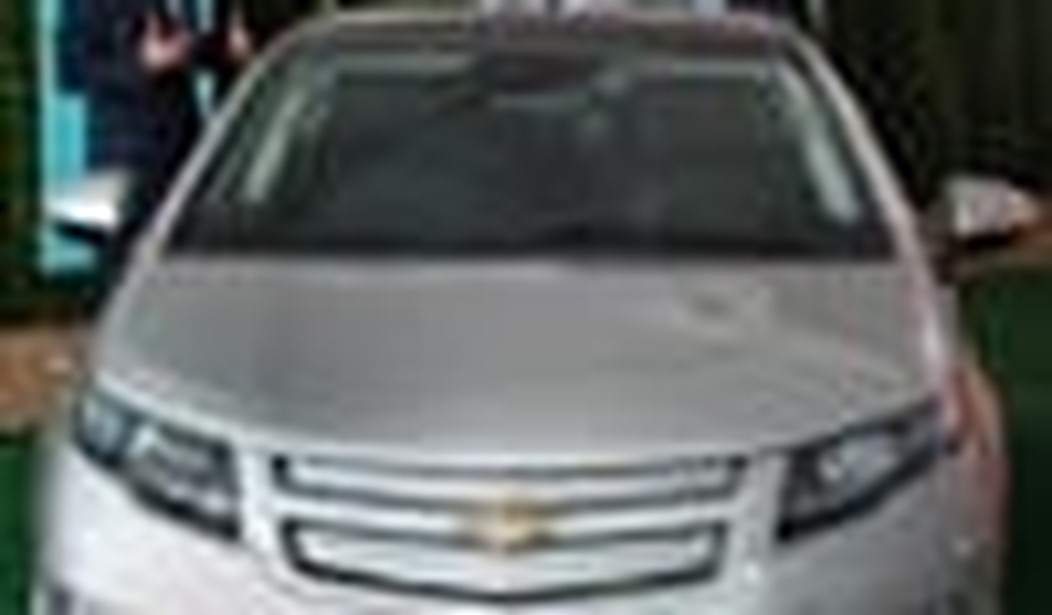The Scene: An executive conference room at General Motors HQ. The mood: grim.
CEO: “Thanks for that report, Tom. What’s next on the agenda, Bob?”
Executive Vice President #1: “Uh, Steve Jenkins from Chevrolet is here to report on the Volt task force.”
CEO: (Perking up) “Ah! Some good news at last!”
Jenkins: (Nervously) “Uh, Mr. Chairman, I’m afraid the news isn’t so good…”
CEO: (Frowning) “Just get on with it.”
Jenkins: (Swallows) “Well, the Volt is only getting about 25 miles per charge…”
Executive Vice President #2: “Wasn’t it supposed to get 50?”
Executive Vice President #3: “Nah. That was marketing hype. Forty is more like it.”
CEO: “Forty? Didn’t I just hear Jenkins say 25?”
Jenkins: (Sweating) “Well, Mr. Chairman, it seems that customers are insisting on carrying passengers, using air conditioning, the heater, the radio, lights, turn signals, and other accessories like that.”
EVP#3: “Oh yeah. That kind of frivolous, luxury stuff will really drain the battery fast.”
CEO: (Sighs) “Go on.”
Jenkins: (Wipes sweat from his brow) “Uh, well, our sales volume is (whispered) 1210 units…”
CEO: “What’s that? How many?”
Jenkins: (Pale and stuttering, a little louder) “Uh, um, 1210 units?”
CEO: “One thousand two hundred and ten units?! For last month?
Jenkins: (About to pass out) “Well, uh no, that’s…that’s for 2011.”
CEO: “For 2011?! But that’s not enough profit to keep the employee restrooms in toilet paper!”
Chief Accountant: “Actually, if we use the new, low-fiber content toilet tissue, the kind you can actually see through, it…” (CEO shoots him an angry look and he shuts up) “…ahem.”
CEO: “Isn’t there any good news about this battery-powered wonder?”
Jenkins: (Nervously clears his throat) “Well sir, the heater works better than we thought it would.”
CEO: “The heater? Better?”
EVP#2: “Actually Mr. Chairman, we didn’t expect it to work at all, but it has proved to be at least substandard.”
CEO: “Substandard?”
EVP#3: “Oh, at least substandard, Mr. Chairman, easily.” (EVP#2 and EVP#3 nod in happy agreement)
CEO: “Great.”
Executive Secretary: (Bursts breathlessly into the room) “Mr. Chairman, Mr. Chairman!”
CEO: “What is it?”
ES: “We’re saved!” (Triggers a remote control and the massive bar along one side of the room transforms, Bond-villain-like, into an enormous TV screen) “Look!”
Barack Obama fills the screen. The executives prostrate themselves before the screen for several minutes as Mr. Obama conducts a stirring teleprompter reading. At the conclusion of the reading, all heads turn, expectantly, toward the CEO.
CEO: (Aside to EVP#1) “Crank up the assembly line! We’re going to sell every unit of this sucker we make.” (To the assembled executives) “Bonuses for everybody! It’s on the taxpayers!”
The scene fades, executives raising a rousing cheer amid backslapping, booze swilling, etc.
What did the excited GM executives learn? In a March 30 speech in Washington, Mr. Obama announced his mandate that 100% of the federal vehicle fleet be “advanced technology” vehicles by 2015. This means that every vehicle in the federal fleet — some 600,000 currently — will have to be a hybrid or electric vehicle. In an extraordinary coincidence of the kind so common during the Age of Obama, General Electric — headed by Jeffrey Immelt, the chief of the president’s Council on Jobs and Competitiveness — will contribute to the brave new “advanced technology” future by buying at least 12,000 Chevy Volts.
For taxpayers, this mandate means extraordinary and unnecessary additional costs. For example, the conventionally fueled Chevy Cruze, the platform on which the Volt is based, would cost approximately $17,000 per unit. For 100 vehicles, that’s $1,700,00. Replace those with the Volt at $41,000 per unit and the figure skyrockets to $4,100,000. It’s just too frightening to contemplate the cost of 600,000 Volts. Hybrid vehicles cost substantially more than comparable conventional vehicles. While it might be possible, with very conservative driving, to recoup that additional initial expense with money saved through higher mileage for some hybrids, the taxpayer will be forever in the hole for every Volt purchased.
Don’t some government employees, law enforcement officers, park rangers, or BLM employees require SUVs, pickups, trucks, or other specialized vehicles that do not come in “advanced technology” trappings? Can a dead moose fit in the trunk of a Volt? I think there’s a joke in there somewhere. Mr. Obama’s mandate, of course, has a loophole that exempts him, allowing him to travel in style in enormous, conventional SUVs.
Until the enlightened Age of Obama, the free enterprise system was pretty easy for manufacturers to understand. Identify a market, build a product that market wants to buy at a price they’re willing to pay, and rake in the profits. Unfortunately for corporate America and the taxpayer, the proverbial monkey wrench has been thrown into the works by Mr. Obama and his economic advisors — whose only advice seems to be to wreck the economy by spending as much money as possible.
I’ve been following the dim fortunes of the Chevy Volt for some time (here, here, here, here, and here). The Volt is an electric pseudo-hybrid compact with a $41,000 manufacturer’s suggested retail price (MSRP) — currently selling for as much as $65,000. To “incentivize” the Volt, the Obama administration is providing a $7,500 tax rebate for each sale, a tax rebate it is planning to turn into a direct, point-of-sale rebate in the near future. After all, cash for clunkers was so economically stimulating, this gesture should make Volt sales explode. (Considering the tendency of lithium-ion batteries to do, more or less, just that, this may not be the most encouraging analogy.)
The Volt’s abysmal all-electric range is supplemented by a weak gasoline engine that requires premium fuel. Charging requires up to 12 hours, but may be halved for an additional $2,000 (installation costs not included) for a special 220V home “fast charger.” Depending on the kind and quality of home wiring, installation costs may be daunting. The charger draws so many amps that considerable rewiring may be required, and proud Volt owners may not be able to use any other high-amp appliances (vacuum cleaners, microwave ovens) while their Volt is charging. Remember that the Volt’s only potential claim to real-world practicality — apart from green street cred — is its high-tech electric drive system which promises unlimited gasoline-free miles. Consider that there is no actual charging infrastructure out there in the real world — not that this will matter in parts of the country that experience actual winter. Cold has the unfortunate effect of rapidly draining and even disabling batteries.
The fictional GM executive wasn’t kidding. Volt sales volume is abysmal, and while GM won’t admit it, even at $41,000 MSRP it is almost certainly losing money on every car. In a genuinely free market, this should not be surprising. After all, for something between $33,500 and $57,500 (that’s minus the $7500 tax rebate), plus more than $2,000 for a charger (installation not included), anyone can be the proud owner of a car that will likely get no better mileage than many conventional vehicles which cost tens of thousands of dollars less. Who could resist that siren song? As it turns out, just about everyone.
Who are the proud Volt owners? Young first-time car buyers? No. Young families? Unlikely. Buyers of limited means? Certainly not. The premium prices being forked over suggest that Volts are the exclusive province of green types and/or the wealthy who can afford as much as $65,000 for a novelty car with no advantage over conventional vehicles available at a fraction of the price.
Pre-Obama businessmen would likely think GM’s decision to put the Volt into production is sheer lunacy, and they would be right. It would surely seem to them that in trying to recover from bankruptcy, GM is plunging headfirst back into bankruptcy. Why else would it build a car featuring not-ready-for-prime-time technology, a car with a tiny to all-but-non-existent potential market? Surely they would consider this to be a shocking, inexplicable display of ignorance or of contempt for the principles of free enterprise? Of course — unless the principles no longer apply.
Just four years from now, Mr. Obama has mandated a CAFE average of 35.5 MPG for all manufacturers. The current average achieved is 22.2 MPG. It is not possible, with current technology, to say nothing of customer preferences, to reach this absurd goal. Only the production and sale of huge numbers of “advanced technology” vehicles will allow GM to avoid huge fines for failing to engineer technologically ignorant wishful thinking.
In GM, taxpayers have a corporation partially owned by the government of Barack Obama. GM management surely understands the wishes of Mr. Obama and his bureaucrats, and the consequences for ignoring them, despite Obamaite claims to have no role or influence in daily operations. What else explains a company trying to recover from bankruptcy by making, at great cost, a product with no real market that can only succeed in the long term with the development of a nationwide charging infrastructure that no one is lining up to build? It seems clear that one power most satisfying for the Obama administration is the ability to pick winners and losers, to award friends and punish enemies. Why not also assume the power to mandate and make manifest markets where none previously existed?
What better market for a car no one wants than a government work force that is now at an all-time record of 2.15 million and constantly increasing? And what better way to provide the transportation needs for that artificially conjured market than “advanced technology” vehicles that will cost substantially more than comparable conventional vehicles? Forget not the astronomical additional cost of the huge charging infrastructure that will be, of necessity, installed at federal facilities throughout the nation. Mr. Obama will no doubt tout the plethora of jobs “saved or created” in this pursuit, for the few weeks — or months — that they last.
From where will come the extra electric generating capacity necessary to power this short-ranged but mighty green fleet? Has not Mr. Obama essentially shut down the construction of new power plants, despite his recent rhetoric seemingly to the contrary? The charging infrastructure alone will represent one of the most egregious cases of corporate welfare and cronyism in American history. Guess which corporation currently close to Mr. Obama’s heart and the taxpayers’ pocketbooks is already marketing EV charging stations? That’s right: General Electric. What a coincidence.
Won’t the $7,500 rebate help? GM tried that already when it announced that it had paid off one of its government loans early — by using money loaned to it from federal TARP funds. The Obama administration is certainly not above financial chicanery, but taking money out of a left pocket only to transfer it to the right might embarrass even Timothy Geithner or Ben Bernanke.
Whether the economic damage already wrought through action and inaction by Mr. Obama can be undone remains an open question. With his political wings clipped by a Republican House, Mr. Obama plainly intends to do by executive mandate what the law and legislature will not allow, and this end run around free enterprise is but a single recent example. With projects like this vehicular “advanced technology” boondoggle, it seems ever more likely that economic ruin is the future — a future into which Mr. Obama is plunging the nation with advanced technology, at warp speed.









Join the conversation as a VIP Member